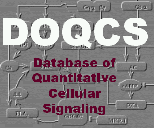| | Name | Initial Conc. (uM) | Volume (fL) | Buffered |
| 1 | AA | 50 | 1000 | Yes |
| | Arachidonic Acid. This messenger diffuses through membranes as well as cytosolically, has been suggested as a possible retrograde messenger at synapses. |
| 2 | PKC-AA* | 0 | 1000 | No |
| | This is the membrane-bound and active form of the PKC-AA complex. |
| 3 | PKC-active | 0 | 1000 | No |
| | This is the total active PKC. It is the sum of the respective activities of PKC-basal* PKC-Ca-memb* PKC-DAG-memb* PKC-Ca-AA* PKC-DAG-AA* PKC-AA* I treat PKC here in a two-state manner: Either it is in an active state (any one of the above list) or it is inactive. No matter what combination of stimuli activate the PKC, I treat it as having the same activity. The scaling comes in through the relative amounts of PKC which bind to the respecive stimuli. The justification for this is the mode of action of PKC, which like most Ser/Thr kinases has a kinase domain normally bound to and blocked by a regulatory domain. I assume that all the activators simply free up the kinase domain. A more general model would incorporate a different enzyme activity for each combination of activating inputs, as well as for each substrate. The current model seems to be a decent and much simpler approximation for the available data. One caveat of this way of representing PKC is that the summation procedure assumes that PKC does not saturate with its substrates. If this assumption fails, then the contributing PKC complexes would experience changes in availability which would affect their balance. Given the relatively low percentage of PKC usually activated, and its high throughput as an enzyme, this is a safe assumption under physiological conditions. |
| 4 | PKC-basal* | 0.02 | 1000 | No |
| | This is the basal PKC activity which contributes about 2% to the maximum. |
| 5 | PKC-Ca | 0 | 1000 | No |
| | This intermediate is strongly indicated by the synergistic activation of PKC by combinations of DAG and Ca, as well as AA and Ca. PKC by definition also has a direct Ca-activation, to which this also contributes. |
| 6 | PKC-Ca-AA* | 0 | 1000 | No |
| | Membrane bound and active complex of PKC, Ca and AA. |
| 7 | PKC-Ca-DAG | 0 | 1000 | No |
| | This is the active PKC form involving Ca and DAG. It has to translocate to the membrane. |
| 8 | PKC-Ca-memb* | 0 | 1000 | No |
| | This is the direct Ca-stimulated activity of PKC. |
| 9 | PKC-cytosolic | 1 | 1000 | No |
| | Marquez et al J. Immun 149,2560(92) est 1e6/cell for chromaffin cells Kikkawa et al 1982 JBC 257(22):13341 have PKC levels in brain at about 1 uM. The cytosolic form is the inactive PKC. This is really a composite of three isoforms: alpha, beta and gamma which have slightly different properties and respond to different combinations of Ca, AA and DAG. |
| 10 | PKC-DAG | 0 | 1000 | No |
| | This is a DAG-bound intermediate used in synergistic activation of PKC by DAG and AA. |
| 11 | PKC-DAG-AA | 0 | 1000 | No |
| | Complex of PKC, DAG and AA giving rise to synergistic activation of PKC by DAG and AA at resting Ca. |
| 12 | PKC-DAG-AA* | 0 | 1000 | No |
| | Membrane translocated form of PKC-DAG-AA complex. |
| 13 | PKC-DAG-memb* | 0 | 1000 | No |
| | Active, membrane attached form of Ca.DAG.PKC complex. |
| | Target | Inputs |
| 1 |
PKC-active | PKC-DAG-AA*
PKC-Ca-memb*
PKC-Ca-AA*
PKC-DAG-memb*
PKC-basal*
PKC-AA*
|
This is the total active PKC. It is the sum of the respective activities of PKC-basal* PKC-Ca-memb* PKC-DAG-memb* PKC-Ca-AA* PKC-DAG-AA* PKC-AA* I treat PKC here in a two-state manner: Either it is in an active state (any one of the above list) or it is inactive. No matter what combination of stimuli activate the PKC, I treat it as having the same activity. The scaling comes in through the relative amounts of PKC which bind to the respecive stimuli. The justification for this is the mode of action of PKC, which like most Ser/Thr kinases has a kinase domain normally bound to and blocked by a regulatory domain. I assume that all the activators simply free up the kinase domain. A more general model would incorporate a different enzyme activity for each combination of activating inputs, as well as for each substrate. The current model seems to be a decent and much simpler approximation for the available data. One caveat of this way of representing PKC is that the summation procedure assumes that PKC does not saturate with its substrates. If this assumption fails, then the contributing PKC complexes would experience changes in availability which would affect their balance. Given the relatively low percentage of PKC usually activated, and its high throughput as an enzyme, this is a safe assumption under physiological conditions. |
